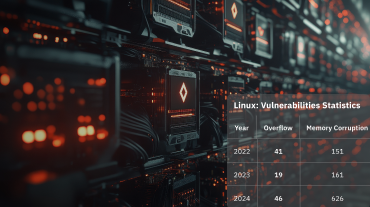High-impact attack: DDoS
Recent high-impact DDoS attacks have caused significant damage to the target, such as taking down a website for an extended period of time, causing financial losses, or compromising sensitive data. For instance, just in February 2023, a massive, record-breaking DDoS attack that peaked at 71 million requests per second (RPS) was discovered. Less than 8 months ago, Google also exposed the largest Layer 7 DDoS reported to date, dubbed as at least 76% larger than the previously recorded attack. How big? It reached 46 million RPS.
As evidenced, in recent years, the frequency and scale of DDoS attacks have risen significantly, with attackers using increasingly sophisticated techniques to amplify their attacks and evade detection.
Besides, distributed denial-of-service (DDoS) attacks pose a serious threat to the security of the IoT that has widely expanded due to its advantages in enhancing the business, industrial, and social ecosystems. Nevertheless, IoT infrastructure is susceptible to several cyber-attacks due to the endpoint devices’ restrictions in computation, storage, and communication capacity. Attackers can easily utilize IoT devices as part of botnets to launch DDoS attacks by taking advantage of their flaws.
The impact of DDoS attacks can be severe, particularly for businesses and organizations that rely heavily on their online presence to conduct business or communicate with customers.
To mitigate the risk of high-impact DDoS attacks, organizations need to be proactive in their approach to cybersecurity, implementing robust defenses such as firewalls, intrusion detection and prevention systems, and content delivery networks (CDNs). They should also have a plan in place for responding to an attack, including incident response procedures and communication protocols to keep customers and stakeholders informed.
Impact of Leaving DDoS Attacks Unchecked
DDoS attacks can be incredibly damaging to businesses and organizations for several reasons:
- Service Disruption: DDoS attacks are designed to flood a target network or server with a huge volume of traffic, overwhelming its capacity to handle legitimate traffic. This can cause the target system to slow down or become completely unresponsive, disrupting critical services and operations.
- Revenue Loss: DDoS attacks can result in significant revenue loss for businesses, particularly those that rely on their online presence to generate sales and engage with customers. If a website or service is unavailable for a prolonged period of time, customers may seek out alternative providers, resulting in lost business and brand damage.
- Reputation Damage: DDoS attacks can also cause reputational damage to a company or organization. If customers are unable to access their services or if their systems are perceived as vulnerable to attack, this can lead to a loss of trust and confidence in the brand.
- Data Breach Risk: In some cases, DDoS attacks may also be used as a diversionary tactic, designed to distract security teams while attackers attempt to breach sensitive data or systems. This can result in a significant data breach and associated costs, including regulatory fines, legal action, and remediation costs.
Traditional Security Approaches Challenges
Detecting a DDoS attack manually can be difficult due to several factors:
- Large Volume of Traffic: DDoS attacks typically involve a large volume of traffic that can quickly overwhelm a network, making it difficult to distinguish between legitimate and malicious traffic. With millions of packets being transmitted, identifying which packets are part of the attack can be challenging.
- IP Spoofing: DDoS attacks often use IP spoofing to mask the true source of the attack, making it difficult to identify the attacker. With IP spoofing, the attacker can generate traffic that appears to come from a legitimate source, making it more difficult to block.
- Distributed Nature of the Attack: As the name suggests, DDoS attacks are distributed across multiple systems, making it difficult to identify the source of the attack. With an attack originating from many different sources, it can be difficult to determine which systems are compromised.
- Multiple Attack Vectors: DDoS attacks can take many forms, including volumetric attacks, TCP SYN floods, and application-layer attacks. Each type of attack requires a different defense mechanism, making it difficult to identify the specific type of attack and the appropriate response.
- Short Duration of the Attack: DDoS attacks can be short in duration, often lasting only a few minutes. In this short period, it can be difficult to identify and respond to the attack, making it more likely that the attack will succeed.
- Rapidly Evolving Tactics: DDoS attackers are constantly evolving their tactics, using new techniques to avoid detection and bypass security measures. This means that security professionals need to stay up-to-date with the latest attack methods and be prepared to adapt their defense strategies.
Combating DDoS Attacks with AI and Automation
By harnessing Artificial Intelligence and Machine Learning, it’s possible to protect digital assets from even the most deadly DDoS attacks with zero impact on legitimate users. Here are some ways Cyber AI can help with DDoS attack detection:
Real-time Monitoring: Machine learning algorithms can be used to detect patterns in network traffic and learn what is normal behavior. When there is an abnormal pattern, the algorithm can flag it as potentially malicious. AI can monitor network traffic in real-time, identifying traffic patterns and detecting anomalies as they occur. This allows security professionals to respond quickly and mitigate the impact of an attack.
Behavioral Analysis: AI can perform behavioral analysis to detect at the earliest stage unusual patterns in network traffic that may indicate an attack. By analyzing the behavior of network traffic over time, AI can learn what is normal and identify deviations from that pattern.
Predictive Analytics: Predictive analytics can help identify potential DDoS attacks before they happen. AI can analyze data and identify patterns that suggest an attack is imminent. This information can be used to take proactive measures to prevent an attack from occurring.
Automated Responses: AI can be used to automate responses to DDoS attacks. For example, AI can work with network security systems to automatically block malicious traffic and reduce the impact of an attack.
Advanced Correlation: AI can be used to correlate data from multiple sources, including network traffic, user behavior, and external threat intelligence feeds. By correlating this data, AI can identify more complex attacks that may not be immediately obvious using other detection methods.
In the context of machine learning models for detecting network threats such as DDoS attacks, precision and recall are two important metrics used to evaluate the performance of models. Precision refers to the proportion of true positive predictions (correctly identified threats) among all positive predictions made by the model. High precision means the model is good at avoiding false positives, i.e., identifying normal traffic as a threat. To illustrate, the cutting-edge solutions deliver 99.1% precision at a high intensity of DDoS attacks.
Recall on the other hand refers to the proportion of true positives among all actual positive cases (actual threats). High recall means the model is good at detecting all actual threats even if it also identifies normal traffic as a threat delivering 99% recall at a high intensity of DDoS attacks.
In summary, a solution that incorporates AI and automation is needed to protect the organization from DDoS attacks. This is exactly what AI EdgeLabs can offer to businesses across all industries. As a result, organizations benefit from:
- Instant, seamless mitigation of known attacks, with no impact on legitimate users.
- Never-seen-before DDoS attacks mitigated in under 10 seconds.
- Full protection against DDoS attacks, with guaranteed availability of 99%
- A huge reduction in cyber risk and potentially millions saved on DDoS attack damages.
Read about best practices and techniques to avoid DDoS attacks with AI.












